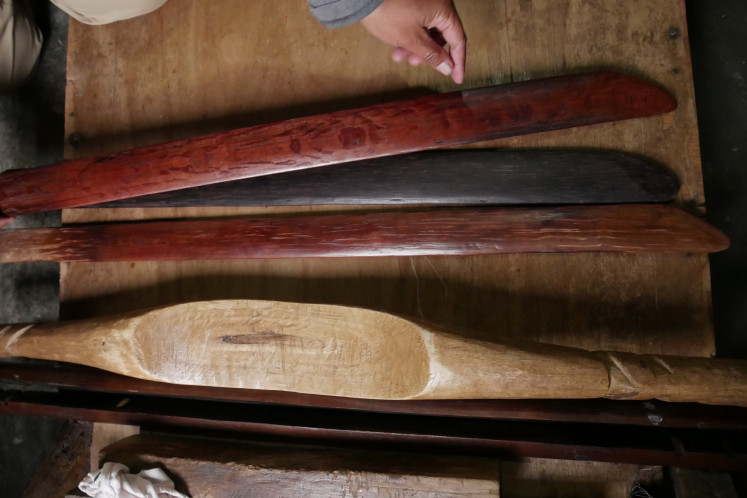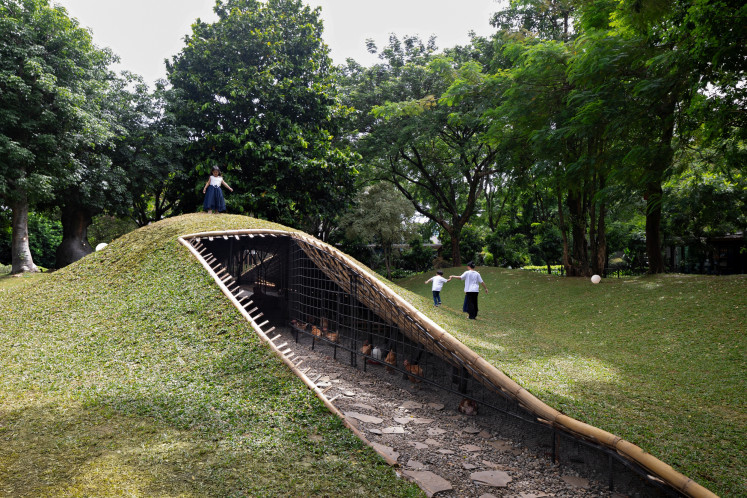Popular Reads
Top Results
Can't find what you're looking for?
View all search resultsPopular Reads
Top Results
Can't find what you're looking for?
View all search resultsA Batak tale of weaving: Preserving tradition and beliefs
Change text size
Gift Premium Articles
to Anyone
U
li Artha Panggabean is a weaver of ulos, the traditional woven cloth of the Batak tribe. Her passion for the tradition goes deep.
Forty-three-year-old weaver Uli Artha Panggabean often posts online about the deforestation occurring on the shores of Lake Toba, North Sumatra. Her anxiety is not without reason; many raw materials used to make ulos come from the forest, including wood to make looms and various plants to make the dyes.
Uli has been interested in weaving since a young age.
“Maybe being an ulos weaver has become my life’s destiny. The more I stay away from it, the more it calls me,” Uli said.
Uli is in the third generation of ulos weavers from her family lineage, with her grandmother and mother coming before her. Neither her grandmother nor her mother had wanted Uli to become a weaver.
Like most traditional Batak parents, her mother wanted her to go to school, find a well-paying job and become an office worker or civil servant, anything but an ulos weaver.
After school, Uli left her village and worked for a company in another city. In 2013, she returned to her hometown, firm in her dream to become an ulos weaver.
Uli was by then proficient at weaving several types of ulos, but wanted to master the ragidup ulos weaving, the ulos that is considered the most difficult to weave.
She dove further into that obsession after her grandmother died in 2021 at 92, and there was no more opportunity to learn from her.
“I cried because there was one less true ulos weaver,” Uli said.
After her grandmother’s death, she returned to her mother and asked her to teach her the ragidup ulos weaving technique, which her grandmother had also mastered. But her mother refused to teach her.
“From generation to generation, there is a myth that a woman whose spirit is not strong enough can get sick or die young while learning ulos weaving. Of course, no parents want their daughters to experience that. Many weavers believe that myth,” Uli said.
Because her grandmother did not want to pass on her knowledge, her mother finally chose to learn weaving from other weavers and secretly watched her mother weave. Uli had the same experience as her mother.
Goods: Looms used by Uli Artha to weave 'ulos'. (JP/Tonggo Simangunsong) (JP/Tonggo Simangunsong)“Even though my mother didn’t teach me directly, I wanted to teach myself by watching her weave,” she said. But the more Uli tried to learn from her mother, the more difficult it became.
“Our spirits were sometimes as if at war; I do not know why. My mother and my grandmother used to be like that too. Even so, maybe because of the relationship between mother and daughter, we still miss each other.”
Following rituals, defying myths
As if destined to become an ulos weaver, Uli mastered her technique in ulos weaving, especially the ragidup ulos weaving technique.
“The highest technique in ulos weaving is making the ragidup,” she said.
Head of the Center for Documentation and Study of Batak Culture, University of HKBP Nommensen Medan, Manguji Nababan, told The Jakarta Post ulos is a cloth permanently attached to Batak culture and its people. The fabric is used in particular moments, from the birth of a child to marriage and death.
Nababan says ragidup is the highest level of all the ulos and contains a philosophical value. Ragidup symbolizes life, hope for offspring, happiness and blessings of longevity.
“Ragidup usually takes 19 days to make, and if a weaver can’t work on it for that long, its weaver usually throws it away,” said Nababan.
As Uli said, the ragidup ulos making is done in three parts. The third part is the most challenging. The technique is called mangarapot. The weaving technique unites the two parts of the loom with a thread-splicing strategy so the ulos blend perfectly.
“Connecting red to white threads, two parts in one weave. That’s the most difficult part,” Uli said.
Before starting the most challenging stage, weavers usually cook buffalo meat, its blood thickened to resemble tofu. This is part of the tradition that Uli calls an “obligation”. It is eaten cooked with local spices.
Uli said while eating the buffalo before weaving was contrary to the Christian belief (against animal sacrifice) she held, she did it because it was part of the tradition, and she wanted to respect her ancestors. “I didn’t want to take any wrong steps; maybe people say I follow animism, but I don’t care,” said Uli, whose father was a priest.
Likewise, when she learned the knowledge of ragidup weaving from her mother, she also fulfilled her obligations. She gave her eggs, a chicken and money as a token of gratitude. Her mother cried when she received the items.
She wants to continue perfecting her weaving, even though she admits she has woven ragidup. One of her ragidup is now owned by a Batak living in Den Haag, the Netherlands.
“I know there are several ragidup ulos weavers, and if the knowledge they have is not learned and passed on to the next generation, I am afraid this knowledge will be lost.”












